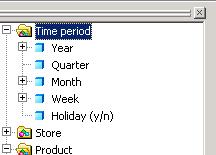Fusion Charts for dashboarding
I’ve been working alot with Fusion Charts lately and found that Fusion Charts is able to produce the Wow factor that most of the other big name dashboarding tools produce. FusionCharts comes in a free version and a professional version. The free version comes with 18 charts however these charts are quite bland and I would recommend buying a license for the professional version since you are...
April 24th, 2009 by David Lai
Auto Incrementing a dimension primary key in SSIS
While working with SSIS to generate star schemas, a common problem I faced was populating a dimension table from another table that did not contain any ids for the items being inserted. If you would try to insert the dimension data without any keys, an error would be thrown since the id field cannot be null. An easy solution is to have a script populate the id column. In this example we take a table...
March 10th, 2009 by David Lai
Cascading List of Values
List of Values is a powerful feature that allows users to select from a pick list when setting conditions in a query. This is especially important if you want to query on codes linked to a set of products. Using the List of Values feature, you will not need to memorize which codes go to which products. The part that I would like to focus on is Cascading List of Values. In a real world Data warehouse...
January 8th, 2009 by David Lai
Happy new years to all the readers!
I’d like to wish everyone who reads the blog a great and prosperous 2009! I’ve been on vacation for the last month but now I’m back so hopefully I’ll be writing articles more often 🙂 Thanks again to everyone who reads my blog and I hope that my articles have proven useful 🙂 Cheers David
January 8th, 2009 by David Lai
Best Practices for Organizing and Naming Objects
While working with many Universes, I’ve noticed that sometimes not enough attention is given to naming objects and the ordering of objects. This in turn may cause confusion with the business users since they are not completely clear on what each of the objects do. Ordering of objects When you have objects of the same class grouped together, it makes it much clearer to the business user to view...
December 4th, 2008 by David Lai
Preventing Chasm and Fan Traps!
In this article I would like to talk about Chasm traps and Fan traps. These are problems that we often experience while building universes and reports. When encountering these traps, one may wonder what is going on? How come my sum statements arent adding up correctly? Or why am I missing some rows? A properly designed universe will help avoid these problems. In addition, a good understanding about...
November 18th, 2008 by David Lai
Content Management planning in Business Objects Enterprise
Proper content management planning is a critical element in the design process of a Business Objects enterprise system, unfortunately because of tight deadlines and lack of experience, many times there is not enough time spent here and users are left with a system that’s unorganized and tough to maintain. I have experienced this first hand so I would like to write about some simple measures to...
November 6th, 2008 by David Lai
All you need to know about opendoc
I’ve seen quite alot of postings in the Business Objects forum on calling the opendoc function from either a web intelligence report or Xcelsius dashboard. You can download the pdf instructions on all the opendoc parameters here opendoc detailed instructions I’ve also provided instructions on drilling down to a Web Intelligence document from Xcelsius here And an Xcelsius open doc worksheet...
November 4th, 2008 by David Lai
Building Scorecards in Xcelsius 2008 and the significance of Global Embedded Fonts
One of the very powerful new additions to Xcelsius 2008 is the ability to create scorecards easily. If we wanted to create scorecards in Xcelsius 4.5 we would need to manually insert trending icons into each row in order to create a scorecard. In Xcelsius 2008 however we can use a label based menu with alerts. The alerts will act as the trending icons and from there we only need one object to show...
October 21st, 2008 by David Lai











